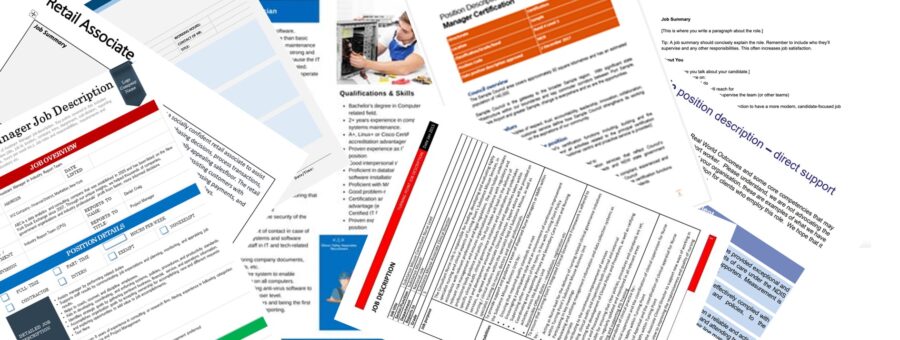A Clear and Concise Position Description Will Always Get You the Right Person for the Job

Shôn Ellerton, Apr 3, 2024
I’ve seen so many role briefs which are so complicated, irrelevant, or vague, that it’s hardly surprising that no person can be found for the job.
Do you frequently come across position descriptions in the job market which are terribly vague, overcomplicated or, simply, confusing?
I certainly do.
The other day, I received a position description from a governmental organisation seeking a Business Intelligence Reporting Analyst as stated in the title of the brief.
Seeing that the brief contained nearly two thousand words, most of which looked like an awful lot of padding, I read the first sentence summarising what the role does and then skipped three pages down to the section outlining what capabilities are needed to fulfil the role.
In less than two hundred words, I knew, without a shadow of a doubt, what they were after. An analyst experienced in putting together a variety of reporting dashboards by extracting data from the organisation’s databases. The capabilities specifically outlined what tools and technologies they are using.
It was that easy.
However, the remaining eighteen hundred words was useless padding serving up such platitudes as to elevate how important and responsible the role is. Essentially to convey to the reader that the kind of person the organisation wants is the best of the best. La crème de la crème!
After reading the remaining text, I could make the assumption that more than three-quarters of those who’ve read it had seeds of doubt growing in their minds as to whether they’d qualify for the role at all.
And I’m not surprised.
If it wasn’t for the title stated that they want a reporting analyst and that there are no direct reports, I’d assume they wanted someone to fulfil a fairly senior position in the organisation.
The first section of the brief elaborates in detail why the role is important within four lengthy bullet points. Here they are in a much more shortened version.
The ability to make strategic decisions and support operations activities.
The continuous expansion of the analytical ecosystem.
Leading the uplift of skills throughout the corporation.
Reducing risk approach to future data initiatives.
After reading this, more than half the applicants could assume that this role requires someone with significantly more experienced than them. And I don’t blame them. Many, especially for those who don’t have a mastery of the English language, may have overlooked the bit in the title stating why the role is important.
Look, I understand that all corporations in the English-speaking world want people with good skills in English and how to communicate. I get that. But, at this point, half the applicants are wondering what sort of calibre person is needed by this organisation. I forgot to mention that the brief of the role, being a governmental one, states its grade, which does not command the sort of salary one would expect for someone being in a senior role.
The next section titled, Key Result Areas, has no less than twenty bullet points within five subsections, in total, of around six hundred words. I would have whittled it down to four out of the twenty bullet points and shortening each of them a little more should I had written the brief.
Here are those amended four bullet points I would have kept.
Develop, test and maintain dashboards, reports and self-service tools.
Identify trends, patterns and anomalies in the data.
Develop datasets to meet reporting needs.
Maintain documentation, naming conventions and metadata standards.
However, check out some of these other bullet points which are, in my opinion, totally unnecessary.
Collaboratively and extensively investigate, analyse and interpret business information needs based on a strong understanding of business processes, drivers and priorities, business frameworks and tools.
Strong understanding of business processes? How strong? Drivers, priorities, business frameworks and tools? Really?
This whole bullet point achieves very little in my view. It is just waffle and padding fit for a game of corporate jargon bingo.
Let’s try this one.
Leverage our tools and definitions to build and support interactive user experiences through dashboards and visuals that provide business units the ability to monitor their respective areas.
Wait. Didn’t we just have a bullet point outlining the need to develop, test and maintain dashboards? This is just a little fancier, the difference being that we have some of those must-have words and phrases which tend to be over-popular like ‘leverage’ and ‘interactive user experiences’.
Here’s a great one.
Support the development of a scalable and flexible data ecosystem, incorporating and advising on emerging technologies suitable for future platform modernisations.
The key word here is, of course, support. However, this wonderfully vague passage either describes something that will never get done or simply to pointlessly inform the applicant that whatever is asked will support the development of a scalable and flexible data ecosystem regardless. I personally never cared much for the indiscriminate use of the word, ecosystem, but that’s my opinion.
This next bullet point is quite leftfield insofar that the candidate’s role has miraculously transformed from a business intelligence reporting analyst to that of a senior mentor in the world of data architecture.
Check this one out.
Educate business units on the importance of data and information, including data models, architecture and methodologies and an intuitive business interface to assist in self-service enquiries.
I don’t even think this fits the role profile at all and, quite frankly, could easily be left out of the position description.
There are so many more, but I’ll throw in one more.
Work with internal and external resources to investigate, determine and implement a workaround to incidents if appropriate, and ultimately to find a resolution.
What strikes me as utterly bewildering with this bullet point is this. In what situation, whether it is at work or at home, does it not facilitate a need to implement a workaround to solve a problem? When one encounters a problem, does one not do anything about it? I highly doubt it.
As if these twenty bullets weren’t bad enough, there’re another thousand or more words describing the ideal person’s specification. You got that right. A complete section titled, Person Specification.
Subdivided into another twenty or so bullet points, the brief expounds on a number of virtues so commonly applied to practically every brief I’ve set eyes on.
Ability to collaborate in a disciplined team with common goals.
Contribute to continuous service improvement.
Critical thinking.
Communication skills.
Being able to display personal leadership.
Apply professional judgement.
Understand the business.
And, of course.
Deliver great service.
Each one of these virtues is further expanded in detail, much of it repeating the same stuff over again.
As for critical thinking, a subject very close to my heart which I’ve touched upon many times throughout my writing, I found it amusing when I read the detail elaborating on the requirement of being able to support the data warehouse systems through overnight processing ensuring maximum availability. Basically, they want you to be on call and willing to work out of hours when asked, and not necessarily to have high levels of skill in critical thinking per se.
And delivering great service? Sure, we all want to deliver great service. So why include it in the brief?
Why am I being so critical with this position description, of which, there are so many like it out there in the world of information technology?
Because, I’ve been on the other side within an IT delivery team itching to get a data engineer who can shift data from A to B and understand how to do this with the tools that we use. We waited for weeks, which ended being months, and yet, no sign of a new data engineer. Somehow or another, amidst the complex machinery powering the recruitment division in large organisations, there was no suitable candidate for the role.
None of us in the team were privy as to who the applicants were. Indeed, none of them were selected for an interview and then we found out that there was something in the order of three hundred applications. And the funny thing is that I knew someone who could fill the role and was looking for such a job. I passed on the details to recruitment, but again, due to internal bureaucracy, they ‘never got around to it’, by which time, he secured a job elsewhere.
The moral of the story is this.
Keep the position description of role brief really clear and concise.
Stop using re-usable templates chucking the same old padding and waffle each time a position description goes out. So many times, I’ve seen requirements in a position description which are so removed in terms of the role’s relevance.
If someone wants to hire a brick mason, don’t put out position descriptions that encapsulate the skills required to be a general contractor. You’re looking for someone who can build a brick wall, not plan and develop a new housing neighbourhood.
Equally so, in the so-called white-collar world, the same reasoning applies.
If someone wants to hire an accountant, don’t make it look like you’re seeking someone who has an intimate knowledge of global macroeconomics or expertise in leveraging the use of futures and options within the stock market.
If any position description or role brief is clear and concise, and to the point, there should be no difficulty finding the right person for the job.


